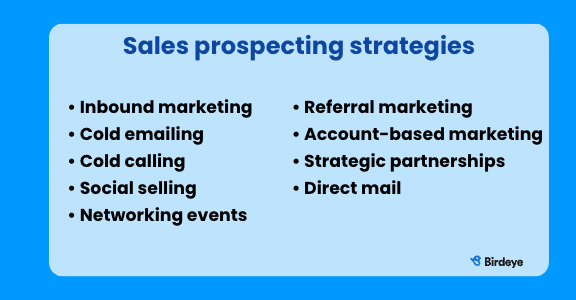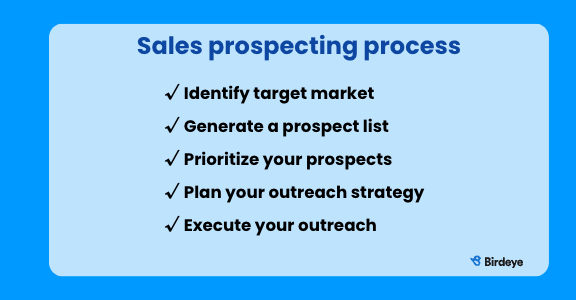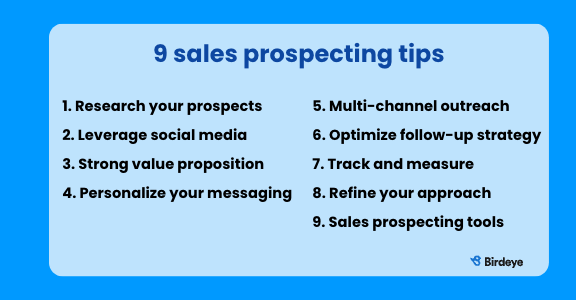Sales prospecting is vital for any business that wants to continuously grow its pipeline. But finding and engaging new prospects takes time, strategy, and effort.
Before social media and marketing automation, companies would fish for new customers by making cold calls and even knocking on doors. Today, businesses use all kinds of channels and sales prospecting tools to generate leads and convert them into customers.
In this ultimate guide, we explain what sales prospecting is and share the best tips for finding valuable prospects you can engage and convert into customers for your business.
Table of contents
What is sales prospecting?
It refers to the steps taken to search for and engage potential customers. The sales prospecting process encompasses all the selling efforts to identify, engage, and convert potential leads. For example, you might contact a prospect on LinkedIn to see if they need your product or service. Or you might respond to a group question about your industry on Facebook to share your offerings.
Difference between a lead and a prospect
They may seem similar, but there are differences. A lead is any person who has interacted with and expressed some interest in your products or service but may not be ready to purchase yet. An example of a lead might be someone who’s shared their email address with you to sample a free product or someone who’s expressed interest in what you do via social media.
Alternatively, a prospect is a qualified lead. It’s a person who’s expressed interest in your products or services and is also likely to become a paying customer. As a business, you’ve verified them by asking questions such as what needs they have and why they are interested in your product or service.
They’ve also confirmed they’re in a position to buy, have the capacity and authority to make buying decisions, and have the budget to do so. An example is someone signing up for a free trial or demo.
Why is prospecting important?
Sales prospecting will generate a list of potential customers who are in the market for your product or service. It’s important that you create these lists of targets so you can build a strategy and usher them through the buyer’s journey. The more leads you have in the pipeline, the more deals you’ll likely close. Without prospecting, you’ll limit your sales potential and cap growth opportunities.
Prospects enter the sales cycle at the top of the funnel when they first become aware of your brand and express interest. From there, your objective is to nurture and eventually convert them into paying, loyal customers. Prospecting, or those steps you take to get people into that first stage of the funnel, is the best way to increase business revenue over time.
Here are a few convincing findings:
- 71% of buyers prefer to be contacted by sellers at the beginning of the purchasing process.
- When a salesperson initiates contact, 82% of prospects are willing to schedule a meeting.
- Top sales prospecting performers generate almost three times as many sales meetings when compared to those who don’t prospect.
Sales prospecting strategies

Inbound marketing
Inbound marketing strategies for finding sales prospects include warm emailing and social selling. Warm emailing is when you send a sales email to a potential customer who’s already expressed interest in your business. Only 24% of sales emails are opened, so be sure you personalize the email to grab their attention.
Cold emailing
Cold emails are unsolicited sales messages you send to potential customers to introduce them to your business. Because they are uninvited, cold emails have an average reply rate of just 8.5%. To encourage engagement, tailor emails to the prospect’s interests and follow up if you don’t get a response.
Cold calling
This involves contacting prospects you haven’t connected with before to introduce them to your brand, products, or services by phone. Cold calling has evolved in the last few decades to focus on targeting the right audience rather than placing random calls.
Although cold calling has a low success rate, it’s the best way to start a relationship with potential customers. Be personable and share valuable content that best addresses their needs.
Social selling
Social media is a great platform for businesses to engage and nurture prospects. In fact, over 50% of salespeople use social media, like LinkedIn and TikTok, for their sales efforts. Social selling also allows for social listening. Social listening lets you learn what your target audience is talking about online and then use those insights to create meaningful interactions.
However, simply answering online questions and pitching on social media won’t cut it. You’ll also need to provide additional value to establish a strong social engagement with prospects. For example, be helpful by offering suggestions, expert advice, and useful links to thoughtfully engage with prospects on social platforms.
Networking events
In-person prospecting still plays a role in lead generation and sales strategies. You can build trust quickly with a handshake and conversation as well as qualify prospects sooner based on those conversations. Start by researching networking events and trade shows you could attend, focusing on those meet-ups that make sense to your business.
Don’t forget to follow up with prospects after the event. While they might not be ready to buy now, cultivating a relationship could result in becoming a paying customer down the line.
Referral marketing
A good prospecting tool is a referral from an already existing and happy customer. Actively seeking out prospect referrals can earn a salesperson 4 to 5 times more compared to if they don’t. Referral marketing is a great tool to help you leverage your existing customers’ networks.
Create your referral marketing strategy by offering incentives to customers like discounts and freebies. Or by starting a loyalty program, where they receive rewards for each referral.
Account-based marketing (ABM)
Account-based marketing (ABM) is a business-to-business (B2B) marketing strategy that lets you focus your sales prospecting process on high-value customers. ABM can generate demand and sales by targeting those prospects with the highest lifetime value. These prospects can represent sizable deals for you once converted. And they’re also more likely to buy additional services that you upsell them.
Start your ABM strategy by first identifying your ideal client profile – prospects with similar characteristics as your top customers. Next, tailor your messaging to appeal to each prospect’s individual needs. Address their pain points, speak their language, and add value to their experience.
Strategic partnerships
Nearly two-thirds of companies today use strategic partnerships to acquire new customers. Collaborating with other businesses is a great way for attracting new prospects. To build strategic partnerships, identify complementary companies in your industry or area and work together to leverage each other’s services.
For example, if you’re a web design company, you could find a digital marketing agency to partner with. Together, you can offer special packages that combine your services and theirs at a discount for customers looking for both solutions. This helps increase the likelihood of landing larger deals and can also expand your reach to a wider audience.
Direct mail
Direct mail is another effective sales prospecting method. In fact, direct mail has a higher ROI than paid search, online display, and text messaging. Moreover, direct mail collateral generates a 4.9% response rate. In comparison, email’s response rate is just 0.6%.
Direct mail can help your business source new leads and guide prospects through your sales funnel. Whether it is signing up on your website or scheduling a free consultation, direct mail fuels conversions. Use strong offers with a rich value proposition and ask for a specific response. Also, add expiration dates to create urgency.
Sales prospecting process

Not every lead is going to be a quality prospect. The following process can help you identify prospects more likely to buy.
Identify and define your target market
The sales prospecting process begins with researching and identifying potential customers who fit your business well. Use various sales prospecting tools to find the right audience. Analyze to see if their needs align with your product or service.
Generate a prospect list and research your prospects
Once you’ve identified your best-fit customers, you can then create a prospect list. Again, a sales prospecting tool can help you build and segment your ideal client profiles. These might be based on company size, yearly revenue, location, job title, etc. For example, someone with a senior leadership title might be a valuable prospect with high buying potential.
Prioritize your prospects
After assembling your lists, the next step involves prioritizing those prospects into qualified leads. Use a lead scoring strategy to identify which are more likely to become new customers. From there, prioritize your time and efforts to the prospects that represent the most value to you.
Plan your outreach strategy and craft personalized messages
The next stage of the sales prospecting process involves implementing various strategies to engage with the prospect. Use sales prospecting emails with personalized customer messaging that speaks to their unique needs.
Execute your outreach
If communication is going well, schedule a live consultation or demo. Then follow it up with a price quote. Once prospects are ready to buy, prepare to negotiate.
This might require addressing more questions, concerns, and possible objections. However, if you demonstrate and articulate your value and offer a reasonable price, you should be able to close the deal.
9 sales prospecting tips for business success

1. Research your prospects
Investigate your prospects before meeting with them. Understand their needs and evaluate if your business would help solve their problem. If the two goals align, it’s a good fit.
2. Leverage social media
High social media activity yields 45% more sales opportunities. Many people use social media networks such as Twitter, Facebook, Instagram, YouTube, and TikTok to search for information. Observe what types of content your prospects are engaging with on these platforms and use that to create compelling content that aligns with their interests.
3. Develop a strong value proposition
Your prospects will respond if they feel they’re getting more than they’re spending. The more value you can offer, the more attracted they’ll become. Articulate your value and how your product or service is a good fit for their needs.
4. Personalize your communication
We’ve mentioned this a few times because it’s so important. Prospects expect businesses to treat them as individuals and cater to their unique experiences. They likely won’t respond to generalized messages or bland outreach.
Personalize your marketing messages to build a relationship. You can use sales prospecting email templates to send welcome emails, cart abandonment emails, and birthday emails to help with engagement. Personalizing the sales journey for your prospects can boost your revenue by up to 40%.
5. Use multi-channel outreach
Don’t restrict yourself to just one prospecting channel. Use a multi-channel approach to widen your reach and attract more leads. Depending on your audience’s preferences, you can explore different outreaching methods such as text messaging, content marketing, and networking events. By using multiple channels to connect, you’ll not only increase your reach to broader audiences but you’ll also stickiness with your brand.
6. Optimize your follow-up strategy
Don’t just reach out once. Develop strategies to follow up with prospects after you’ve connected. It takes five emails or more to get a response on average.
Schedule a meeting or send them relevant information to nurture and guide prospects toward a sale. Keep connecting with them and personalize the messaging every time.
7. Track and measure your efforts
Tracking your efforts provides valuable data. It lets you understand where prospects are in their journey so you know what actions to take next. The metrics will tell you which strategies generated results and which do not.
8. Continuously refine your approach
As you execute your sales prospecting strategy, it’s important to continually test and refine your methods. Needs and preferences will always change, so your approach should be dynamic, too. Study the real-time data and feedback and use those insights to change your pitch to reflect new trends. You can improve over time by trying out alternatives and finding the best options for results.
9. Invest in sales prospecting tools
Prospecting, like other aspects of your business, is easier when you take advantage of emerging sales tools. Consider investing in technology to streamline how you attract and manage prospects and leads. An effective sales prospecting tool will help you capture leads and automatically qualify prospects so you can prioritize who to target first. These tools also provide detailed reports to track your progress and success rates.
Frequently asked questions about sales prospecting
A prospecting strategy is a plan for reaching out to potential customers through email, text, social media, or by phone to gauge their interest in your product or service and generate leads.
The five P’s of prospecting include the following: purpose, preparation, personalization, perseverance, and practice.
Over 40% of sales professionals say prospecting is the most challenging part of selling. Your prospects are busy, their inboxes are full, and their calendars are tight. So, connecting with them often takes time and several attempts.
The golden rule of prospecting is to be well-prepared before reaching out. In other words, make sure you correctly identify whether they’re genuine prospects and have a real need for your product or service.
The secret to successful prospecting is data and consistency. Find the people who require your solution and have the potential to become paying customers. Stick with them consistently until they convert.
Get started with sales prospecting
Sales prospecting is a crucial step in the sales process. By identifying potential leads and reaching out to them in a strategic and personalized way, sales professionals can increase their chances of closing more sales.
It’s important to remember that sales prospecting is an ongoing process that requires consistent effort and analysis. Don’t hesitate to explore and experiment with different prospecting techniques to find what works best for your business.

Originally published


![this is a 1 / 1 – [Feature image] of the blog about 31 irresistible car sales email templates to close more deals.](https://birdeye.com/blog/wp-content/uploads/Feature-image-31-irresistible-car-sales-email-templates-to-close-more-deals-375x195.jpg)
![[Feature image] Are you on these 40+ powerful eCommerce review sites blog](https://birdeye.com/blog/wp-content/uploads/Feature-image-Are-you-on-these-40-powerful-eCommerce-review-sites_-375x195.jpg)